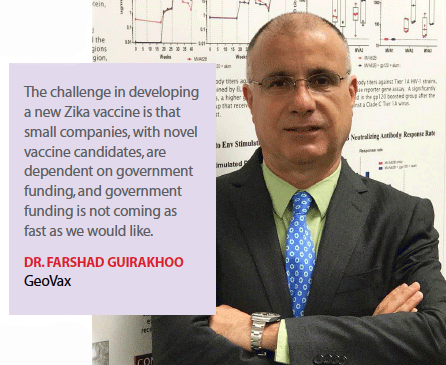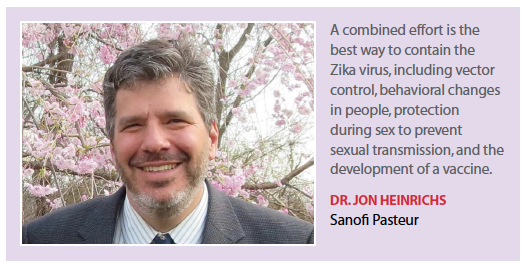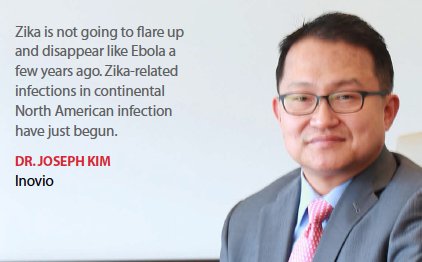 First identified in Uganda in 1947, the Zika virus over the past two years has rapidly spread through Asia, the South Pacific, Hawaii, South America, Central America, and the Caribbean. In 2016, active local mosquito-borne transmission began to occur in North America, specifically in Florida and Texas.
First identified in Uganda in 1947, the Zika virus over the past two years has rapidly spread through Asia, the South Pacific, Hawaii, South America, Central America, and the Caribbean. In 2016, active local mosquito-borne transmission began to occur in North America, specifically in Florida and Texas.
According to the World Health Organization (WHO), as of December 2016, 68 countries and territories (including in the Americas) reported continuing mosquito-borne transmission of the Zika virus, compared with 33 countries in February 2016. The World Bank is projecting the short-term economic impact for 2016 in Latin America and the Caribbean to be about $3.5 billion.
In the United States, as of Dec. 12, 2016, Zika virus outbreaks have been reported in 50 countries and territories in the Americas, according to the Centers for Disease Control and Prevention. More than 4,000 travel-associated cases of Zika have been reported in the United States. A total of 1,172 pregnant women in the United States have been infected with Zika virus.
While the WHO has declared the Zika public health emergency over, industry leaders say the Zika virus is still a threat and remains a public health challenge.
 “That was a rash announcement," Joseph Kim, Ph.D., president and CEO of Inovio, says of the WHO announcement. “Zika is not going to flare up and disappear like Ebola a few years ago. Infections in continental North America have just begun. It’s a matter of time before there are more infections in Florida and elsewhere where there are temperatures and humidity."
“That was a rash announcement," Joseph Kim, Ph.D., president and CEO of Inovio, says of the WHO announcement. “Zika is not going to flare up and disappear like Ebola a few years ago. Infections in continental North America have just begun. It’s a matter of time before there are more infections in Florida and elsewhere where there are temperatures and humidity."
In fact, a team of researchers at Imperial College London predicted in July that the current Zika epidemic is expected to last another three years. But once the current epidemic is over, they say there will be a delay of at least a decade before there are any more large epidemics of Zika virus, because a large percentage of the population will be immune to infection.
Dr. Kim even predicts that in the United States there will be more cases of infection in 2017 than in 2016, with Puerto Rico at the epicenter.
Many aspects of the Zika epidemic and the consequences of Zika infection remain to be understood, but the virus continues to spread geographically to areas where competent mosquito vectors are present, says Gary Dubin, M.D., senior VP and head of global medical office, vaccine business unit, Takeda.
“Zika, therefore, continues to require a swift response that will be best managed with partnerships between governments, public health agencies, medical and scientific communities, and industry leaders," he says. “These partnerships are essential for success.
We at Takeda feel it is important to collaborate with the global health community to urgently address the challenges associated with the Zika situation."
The U.S. population is at risk of Zika infection not only while traveling, but also through mosquito-borne transmission as well as through sexual transmission, says Jon Heinrichs, Ph.D., R&D lead on Zika vaccine, Sanofi Pasteur.
“Overall, a combined effort is the best way to contain the virus, including vector control, behavioral changes in people, protection during sex to prevent sexual transmission, and a vaccine," he says. “Preventing mosquito-borne transmission hasn’t worked well for other Flavivirus diseases, and we don’t think it can be the complete picture here. A vaccine is a critical part of the public health effort in the United States."
 Zika belongs to the Flavivirus family of viruses, which includes yellow fever, dengue, and West Nile virus, which spread to people through mosquito bites. Because the Aedes species of mosquitoes that spread Zika virus is found throughout the world, there is concern that Zika will continue to spread to new countries and regions. Unlike other Flaviviruses, however the Zika virus can be sexually transmitted.
Zika belongs to the Flavivirus family of viruses, which includes yellow fever, dengue, and West Nile virus, which spread to people through mosquito bites. Because the Aedes species of mosquitoes that spread Zika virus is found throughout the world, there is concern that Zika will continue to spread to new countries and regions. Unlike other Flaviviruses, however the Zika virus can be sexually transmitted.
The WHO estimates that more than 2 billion people are directly at risk for infection. Most people who become infected with the Zika virus do not become sick. For the 20% of people who do develop symptoms, the most common symptoms are fever, rash, joint pain, and conjunctivitis.
But infection with the Zika virus during pregnancy can cause serious birth defects, including microcephaly, a condition where a baby’s head and brain are smaller than normal and the brain has not developed properly. This can result in seizures, developmental delays, intellectual disabilities, and hearing and vision problems.
In December 2016, the CDC released results of a study that showed that the Zika virus can cross the placenta and infect the fetus’s brain. Additionally, Zika virus RNA can continue replicating in fetal brains and in placentas for more than seven months. The RNA levels were found to be about 1,000 times higher in the infants’ brains than in the women’s placentas, according to the study published in CDC’s Emerging Infectious Diseases journal. The researchers found the Zika virus infects Hofbauer cells, a type of migratory immune cell in the placenta. Because the Hofbauer cells can move freely throughout the placenta, they may help transfer the virus to the fetus’s brain. Once there, the virus can infect various types of brain cells.
In adults, Zika virus infection is also associated with Guillain-Barre syndrome, which causes muscle weakness of the limbs and, in severe cases, may cause almost total paralysis, including the inability to breathe.
Recent reports suggest Zika may also be associated with other neurological abnormalities and abnormalities in other systems, including ocular and cardiac.
There is no approved therapeutic or vaccine for Zika infection, presenting a major unmet medical need.
 The Zika virus isn’t new; it was first identified about 70 years ago and was found to cause very mild disease in Africa with no indication of microcephaly.
The Zika virus isn’t new; it was first identified about 70 years ago and was found to cause very mild disease in Africa with no indication of microcephaly.
“Then it spread into Southeast Asia, the Polynesian Islands, and Micronesia, where we started to see big epidemics," Dr. Heinrichs says. “We started to see severe disease when it moved to Latin America. We don’t know if the virus changed in some way or whether the population in Africa had developed protective antibody levels."
Dr. Dubin says successful control of Zika, dengue, and other vector-borne diseases will ultimately require a comprehensive set of community-based interventions, including vector control, public education, and ideally, a safe and effective vaccine.
“We are excited to follow the progress of vector control measures, and we view vaccines and vector control as complementary tools to protect communities," he says.
Dr. Heinrichs says the biggest challenge for manufacturers is to move quickly to address the needs of patients in regions of the world where the virus is still circulating.
“In epidemic situations like this, it’s very challenging because to establish efficacy of the vaccine, you need to test it in populations where the disease is spreading," he says. “This virus is burning through populations and moving around the world so quickly that predicting where it will be at any one given time is a challenge."
Research of Zika
The research community is working to address the many unanswered questions about the Zika virus and its impact on infected people and fetuses.
In November 2016, scientists at the U.S. Food and Drug Administration provided a new mouse model that may help researchers to understand the potential activity of Zika virus vaccines and therapeutics. Published in PLoS Pathogens is the description of a neonatal mouse model that provides a platform for potentially improving and expediting studies to understand the causes and effects of the Zika virus.
Better understanding the impact and long-term effects of the Zika virus infection in mice may be useful in efforts to find ways to combat the disease in humans. While past research indicated that only mice with compromised immune systems were susceptible to Zika virus infection, this study shows that neonatal mice with otherwise healthy immune systems are also susceptible.
This is just one of several research projects the FDA has undertaken as part of its efforts to fight the Zika virus. The FDA also has invested in initiatives to understand the effectiveness of technologies that reduce pathogens (such as viruses or other microorganisms that can cause disease) in blood, evaluate the impact of red blood cell storage on virus infection, expand the agency’s database of virus-infected samples essential to the development of diagnostic devices, and explore how long the Zika virus persists in body tissues, among other projects.
The National Institutes of Health also has made studying the Zika virus a priority. In June 2016, the National Institute of Allergy and Infectious Disease and other NIH Institutes launched the Zika in Infants and Pregnancy (ZIP) trial. The study aims to enroll as many as 10,000 pregnant women in as many as 15 sites.
Participants enroll in their first trimester of pregnancy and will be followed throughout their pregnancies to determine if they become infected with Zika virus and if so, what outcomes result for both mother and child. The participants’ infants will be followed for at least one year after birth.
Additionally, NIAID is working with partners in government, academia, and the pharmaceutical and biotechnology industries to better understand Zika, the disease it causes, and ways to combat it. NIAID is accelerating research in areas such as the natural history of the disease, basic research on the Zika virus, how it causes disease, diagnostics to rapidly determine if someone is or has been infected with Zika, and to distinguish from other flaviviruses, as well as treatments and vaccines.
In the area of basic research, the NIAID is working to better understand the Zika virus’ natural history and evolution, viral biology, structure, replication, transmission, and pathogenesis as well as the virus’ interactions with mosquitoes and the human immune response to Zika.
Currently, NIAID is developing animal models that could be used to test and evaluate candidate therapeutics and vaccines. These animal models could also be used to better understand the effects of the Zika virus on the body, especially during pregnancy, and the impact of the virus on the developing fetus.
The Institute also is developing multiple vaccine candidates to prevent Zika virus infection. These include:
A DNA-based vaccine that uses a strategy similar to an investigational Flavivirus vaccine for West Nile virus infection. That vaccine, which was developed by scientists at the NIAID Vaccine Research Center, was found to be safe and induced an immune response when tested in a Phase 1 clinical trial. A DNA-based Zika vaccine candidate entered an early-stage trial at NIAID in August 2016.
A live-attenuated (in which the virus has been weakened so that it cannot cause disease) investigational Zika vaccine building on a similar vaccine approach for the closely related dengue virus. The dengue vaccine candidate was shown to be safe and immunogenic in early-phase trials and is currently being evaluated in a large Phase III study in Brazil.
An investigational Zika vaccine that uses a genetically engineered version of vesicular stomatitis virus — an animal virus that primarily affects cattle. VSV was successfully used in an investigational Ebola vaccine tested by NIAID. This vaccine approach is at an early stage with plans under way to evaluate the Zika vaccine candidate in tissue culture and animal models.
A whole-particle inactivated Zika vaccine based on a similar vaccine approach used by the Walter Reed Army Institute of Research (WRAIR) to develop vaccines against the related Japanese Encephalitis and dengue viruses.
This last effort with WRAIR was announced in November 2016. Scientists with WRAIR, part of the U.S. Department of Defense (DoD), developed the vaccine. This study is expected to be completed by the fall of 2018.
Pharma Research of Zika
Experts agree the need for a Zika vaccine is great. Our experts, as well as those at Imperial College, say developing new vaccines and testing potential interventions are important to prevent another epidemic or contain it quicker than the current outbreak.
“What we’ve learned in recent human history is that the only way to eradicate a disease is to have a proper vaccine against it," Dr. Kim says. “Smallpox, polio, in most cases measles and mumps are infectious diseases that used to create a lot of problems in a large segment of our society up until a few decades ago. We need an effective vaccine for Zika, for Dengue, and for Chikungunya and that will be the long-term, more permanent solution for these infections."
Biopharma companies large and small are working to develop a Zika vaccine using various methods. The vast majority of these are currently in early preclinical trials, indicating that it will take many years until one of them receives market approval.
“Vaccine development is a complex and time-consuming process that includes demonstration of safety and efficacy, usually requiring large clinical trials," Dr. Dubin says. “In addition the establishment of consistently high-quality and rigorously controlled manufacturing processes at large scale is required."
Takeda, for example, started work on its Zika response efforts several months ago. The company is currently conducting preclinical work on its vaccine. In September, Takeda announced that it had received $19.8 million from the Biomedical Advanced Research and Development Authority (BARDA), which will cover the vaccine development through Phase I, with potential for additional funding of up to $312 million.
The vaccine is an inactivated, adjuvanted, whole Zika virus vaccine. This approach has been successfully used to develop several Flavivirus vaccines.
Dr. Dubin says the company expects Phase I clinical studies to begin in 2017.
“We aren’t able to project timing milestones beyond this, but vaccine development typically takes several years after initiation of the first clinical studies," he says. “We will work closely with health authorities to adhere to the latest guidelines on development of a Zika vaccine."
Sanofi Pasteur also has received BARDA funding for its vaccine research, which is in clinical development. Sanofi Pasteur is working with the Oswaldo Cruz Foundation — through its Immuno-biological Technology Institute known as Bio-Manguinhos/Fiocruz — and is collaborating with WRAIR regarding a Zika vaccine using WRAIR’s inactivated-virus vaccine (ZPIV) technology.
WRAIR is providing its Zika purified, inactivated-virus vaccine (ZPIV) candidate to Sanofi Pasteur to produce clinical material in compliance with current GMP (good manufacturing practices) to support Phase II testing, optimize the upstream process to improve production yields, and characterize the vaccine product.
WRAIR — along with the U.S. National Institute for Allergy and Infectious Diseases (NIAID) — will sponsor and support a series of Phase 1 trials.
WRAIR’s Zika vaccine is the first inactivated vaccine to reach the clinic, Dr. Heinrichs says.
“We chose to focus on the inactivated vaccine approach because we’re going to target a population of women who are of reproductive age," he says. “Because of the uncertainties of the virus, we felt that the safest and quickest approach is this traditional vaccine technology, which relies on an inactivated virus approach."
Sanofi Pasteur has developed and provides several vaccines against Flaviviruses, such as yellow fever, dengue, and Japanese encephalitis. It developed its first yellow fever vaccine in 1979 and has since sold more than 400 million doses; it is licensed in more than 100 countries around the world. And more recently, in the last year, Sanofi Pasteur has been providing the first licensed vaccine against dengue fever.
GeoVax’s approach to Zika vaccine development uses a recombinant Modified Vaccinia Ankara virus (MVA) viral vector to produce virus-like particles (VLPs) in the person being vaccinated. The production of VLPs in the person being vaccinated mimics a natural infection, stimulating the immune system to recognize, prevent, and control the target infection.
In human clinical trials of the company’s HIV vaccines (which have completed Phase IIa trials), GeoVax has demonstrated that MVA-VLPs are safe and can elicit strong and durable antibody and cellular immune responses to fight HIV infections.
For the Zika virus (ZIKV), GeoVax is working in collaborations with the University of Georgia Research Foundation and the Centers for Disease Control.
With the CDC, the company has developed an animal model and has performed mouse efficacy studies. ZIKV and reagents will be supplied by the University of Texas Medical Branch.
MVA has been safely administered to 120,000 humans in Germany in a campaign for eradication of smallpox in the 60s and later as a vector for delivery of other vaccines including HIV, malaria and tuberculosis, says Farshad Guirakhoo, Ph.D., chief scientific officer of GeoVax.
“Our Zika vaccine has shown 100% protection against death in a mouse model after a single inoculation," he says. “MVA has been adapted to replicate in chickens, so when it is used in humans as a vector for delivery of other vaccine target antigens, the virus can’t reproduce infectious progeny to spread in the host, making it highly safe for people."
Unlike other companies that are using viruses to create a Zika vaccine, Inovio is developing a DNA-based monoclonal antibody. This DNA-based monoclonal antibody technology has the potential to lead to products that can be designed and manufactured on a large scale using common fermentation technology. Inovio’s DNA-based immunotherapy platform can target both immediate therapy through delivery of dMAb products as well as long-term immunity via DNA vaccination.
Inovio is advancing two trials for its DNA-based Zika vaccine. In the first study, the company’s Zika vaccine (GLS-5700) generated robust antigen-specific antibody responses in a first-in-man, multi-center Phase I trial. In initial testing, Zika-naïve subjects in both low-dose and high-dose vaccine groups demonstrated Zika antigen-specific antibody responses after one or two vaccinations.
In Puerto Rico, where the CDC estimates Zika infects more than 25% of the population, Inovio’s second Phase I study employs a placebo control design that may provide exploratory signals of vaccine efficacy.
Dr. Kim says the company’s DNA vaccines are stable at room temperature, making a vaccine from this technology appropriate for use in higher temperate climates where Zika and many other viruses exist.
“Our vaccines are faster to construct, manufacture, and develop," he says “It’s much easier to scale up the manufacturing, and there is no worry about workers being infected with the virus. Our product is pure DNA in a plasmid form grown in standard E. coli bacteria that’s been used in countless pharmaceutical manufacturing processes."
The company is also working with the Wistar Institute with the goal of developing a DNA-based MAb therapy to treat Zika infection. The program is being funded by an $8.8 million grant from the Bill & Melinda Gates Foundation.
The company hopes to have a product candidate available for clinical development within the next two years.
“This is a novel application of our platform, of DNA plasmids," Dr. Kim says. “Here instead of making antigen proteins using our synthetic DNA platform, we can make a full-length, fully-functional, monoclonal antibody that can bind and take out the Zika virus once the virus is in the patients."
Dr. Kim says Inovio has received a total of $65 million in funding from DARPA, the NIH, and other collaborators to develop these novel DNA-based monoclonal therapies to treat Ebola infection, infections against influenza, HIV, and Zika. (PV)



















